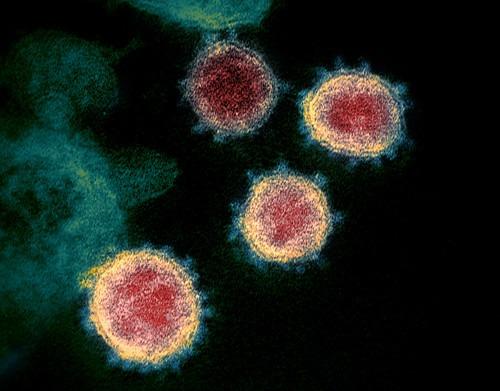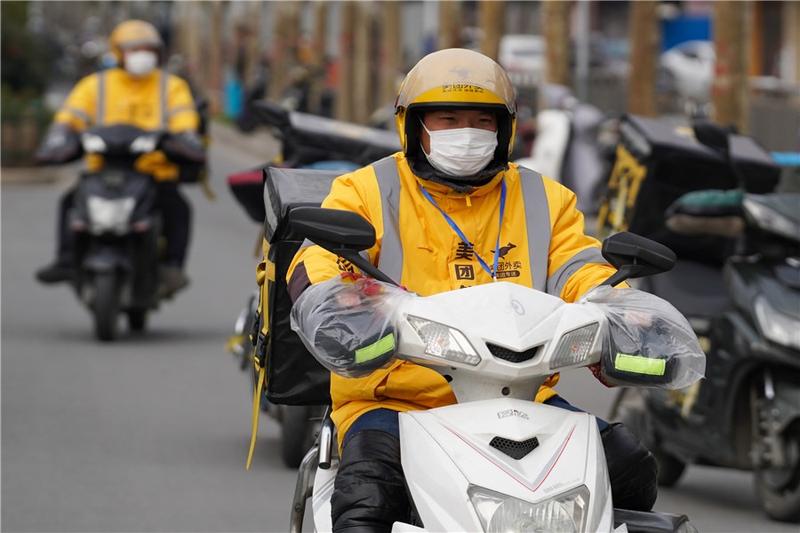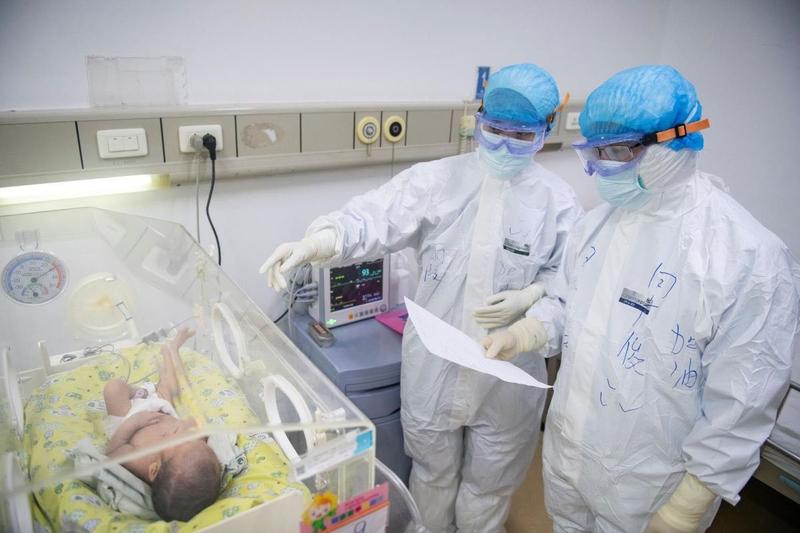 An image of the novel coronavirus (also known as COVID-19) as shown under a scanning and transmission electron microscope. (PHOTO / THE NATIONAL INSTITUTE OF ALLERGY AND INFECTIOUS DISEASES' ROCKY MOUNTAIN LABORATORIES)
An image of the novel coronavirus (also known as COVID-19) as shown under a scanning and transmission electron microscope. (PHOTO / THE NATIONAL INSTITUTE OF ALLERGY AND INFECTIOUS DISEASES' ROCKY MOUNTAIN LABORATORIES)
Since the outbreak of novel coronavirus pneumonia in Central China's Wuhan city, rumors and disinformation about the disease have been spreading, even more quickly than the virus. To dispel fake news and present the truth, here we list some of the rumors spread extensively.
Claim: Novel coronavirus has mutated into a more deadly strain
The novel coronavirus has evolved into two major subtypes, according to latest research findings by Chinese scientists.
The two major subtypes are named L and S. The L type, covering 70 percent of the strains examined, is more aggressive and was more prevalent in the early stages of the outbreak in Wuhan, Hubei province. But instances of the S type, which is older and less aggressive, have increased in frequency lately, thus possibly explaining the disease's slowing momentum in China.
ALSO READ: Nation sets example in fighting virus
The conclusion is still speculative at this stage, and there's no evidence yet showing which type of virus is more likely to be transmitted or lead to severe symptoms to people infected.
A virologist in Beijing who spoke on condition of anonymity said, "It is still too early to say if the virus has mutated into something more sinister or more benign."
 Medics put on protective gear at Wuhan Red Cross Hospital In Wuhan, Hubei province, on Feb 25, 2020. (CHEN ZHUO / CHINADAILY.COM.CN)
Medics put on protective gear at Wuhan Red Cross Hospital In Wuhan, Hubei province, on Feb 25, 2020. (CHEN ZHUO / CHINADAILY.COM.CN)
Claim: Recovered patients who test positive again can transmit the virus
There is currently no evidence that patients testing positive again after recovery from the coronavirus can transmit the virus, said Du Bin, a director at the Peking Union Medical College Hospital.
Tong Zhaohui, vice-president of Beijing Chaoyang Hospital, said patients who test positive again after recovery from the virus are not "reinfected" or "relapsed". They test positive again because a bit of the virus still remains in their bodies when they are discharged from the hospital. It takes some time for the virus to be eradicated from the bodies of some patients, especially seniors.
Recovered COVID-19 patients should be quarantined for 14 days after being discharged from the hospital, according to the latest version of the guideline on the diagnosis and treatment of COVID-19 released by the National Health Commission.
Claim: Novel coronavirus is more deadly than any other pathogen
The fatality rate of the novel coronavirus pneumonia is about 3.4 percent (total deaths divided by the number of confirmed cases), according to the World Health Organization, much lower than the mortality rate of other pathogens, such as Ebola, which has a fatality rate of up to 90 percent.
But it is higher than the death rate of seasonal flu, which is less than 1 percent.
 A doctor teaches a patient to do a pulmonary rehabilitation exercise at Wuhan Red Cross Hospital. (CHEN ZHUO / CHINADAILY.COM.CN)
A doctor teaches a patient to do a pulmonary rehabilitation exercise at Wuhan Red Cross Hospital. (CHEN ZHUO / CHINADAILY.COM.CN)
Claim: Asians are more vulnerable to novel coronavirus
The novel coronavirus, which broke out in Wuhan, China, is fueling racism and prejudice against Asian ethnicity in the world. A lot of Asians complained on social media they've received hate speech, been treated inappropriately, or even abused by people around them.
However, although most cases of the novel coronavirus have indeed been found in China, there haven't been any findings about which groups are more vulnerable to the novel coronavirus.
Claim: Older people are more susceptible
That's not true. The fact is, people of all ages can be infected by the new coronavirus but older people and those with underlying diseases (such as asthma, diabetes and heart disease) are at higher risk of severe illness.
There have been 55,924 lab confirmed cases as of Feb 20. The median age is 51, with the majority of cases (77.8 percent) aged between 30-69 years, according to the Report of the WHO-China Joint Mission on Coronavirus Disease 2019 (COVID-19).
Disease in children is relatively rare with around 2.4 percent of the total reported cases aged below 19. A very small proportion of those aged under 19 patients developed severe (2.5 percent) or critical disease (0.2 percent).
 A delivery man drives to deliver a meal in Nanjing, East China's Jiangsu province, on Feb 19, 2020. (PHOTO / XINHUA)
A delivery man drives to deliver a meal in Nanjing, East China's Jiangsu province, on Feb 19, 2020. (PHOTO / XINHUA)
Claim: The virus was manufactured and leaked from a research lab in China
The Wuhan Institute of Virology, the top virus research agency in China, has been targeted by rumors and controversies since the outbreak. Rumors included the virus being artificially engineered and leaked from the institute's biosafety level-4 laboratory, which studies the deadliest pathogens, such as the Ebola and Marburg viruses.
One article published by The Washington Times on Jan 26 claimed the virus was part of a Chinese biological weapons program based at the institute.
There also were claims that the first patient contracting the virus was a graduate student from the institute and that the head of the institute sold experimental animals to a seafood market, where the first case of infection was reported, and leaked the virus from a lab.
In an open letter published in Lancet on Feb 18, 27 health experts from across the world condemned conspiracy theories surrounding the novel coronavirus.
The letter read "scientists from multiple countries have published and analyzed genomes of the causative agent, severe acute respiratory syndrome coronavirus 2 (SARS-COV-2), and they overwhelmingly conclude that this coronavirus originated in wildlife, as have many other emerging pathogens."
Claim: Is it dangerous to eat at a Chinese restaurant or to receive a package from China?
Owners of Chinese restaurants abroad have reported a downturn in business since the novel coronavirus outbreak, as few customers dare to have dinners there.
The fact is, the novel coronavirus is transmitted mainly by respiratory droplets or direct contact with a patient's body fluids, not through food.
As for packages, previous analysis has shown the virus does not survive long on objects such as letters and packages, so it's safe to receive packages from China.
Eating garlic or Vitamin C helps keep the virus away?
Although garlic is a popular flu remedy in traditional Chinese medicine and may have some antimicrobial properties, there is no evidence that eating garlic does help you fend off the virus.
The same is true with Vitamin C. Many believe that Vitamin C is able to improve immunity, which health experts said is scientifically groundless.
Vitamin C supplements are not an alternative to fresh food. For health people, it is not necessary to take extra supplements to prevent the disease as long as they get enough nutrition from a balanced diet.
As for drinking hot water to kill the virus, it is only another misunderstanding. The novel coronavirus can be killed in water at 56 C or higher after 30 minutes, but it is impossible for human body to lift its temperature to 56 C.
What's more, the virus infects the respiratory tract of human body rather than the digestive tract. Drinking hot water not only is useless, but also hurts your esophagus.
 Medical staff go over plans to treat an baby girl born to a COVID-19 infected woman in Chongqing municipality. (PHOTO PROVIDED TO CHINADAILY.COM.CN)
Medical staff go over plans to treat an baby girl born to a COVID-19 infected woman in Chongqing municipality. (PHOTO PROVIDED TO CHINADAILY.COM.CN)
Claim: Pregnant women can transmit the virus to her child
Up to now, there have been no cases proving newborn coronavirus transmission.
A study published in the Lancet on Feb 12 cited nine pregnant novel coronavirus cases, with all the women giving birth to living and uninfected infants.
A pathogen can infect the fetus through placenta during pregnancy or through blood to a baby's broken skin or mucous membranes during delivery.
Claim: Wearing more than one mask will help prevent infection
Wearing thicker masks or two disposable surgical masks while trying to better prevent transmission of the novel coronavirus does not help and may cause breathing difficulty.
READ MORE: Doctor touts TCM as effective treatment for disease patients
A coronavirus is only 10 nanometers in diameter and can only float in the air attached to other particles, like human droplets, which are much bigger. A mask can help stop the coronavirus if it stops the particles or droplets and a disposable surgical mask is good enough to do that.
Cotton masks, thicker than surgical masks, have bigger pores, which may allow the virus in. Even if it is stopped at the outer surface, the virus may filter inside due to the absorbency of cotton after the mask turns wet during use.


